Abstract
Compactin, an inhibitor of HMG-CoA (3-hydroxy-3-methylglutaryl-CoA) reductase, decreased cholesterol synthesis in intact Hep G2 cells. However, after the inhibitor was washed away, the HMG-CoA-reductase activity determined in the cell homogenate was found to be increased. Also the high-affinity association of LDL (low-density lipoprotein) to Hep G2 cells was elevated after incubation with compactin. Lipoprotein-depleted serum, present in the incubation medium, potentiated the compactin effect compared with incubation in the presence of human serum albumin. Addition of either mevalonate or LDL prevented the compactin-induced rise in activities of both HMG-CoA reductase and LDL receptor in a comparable manner. It is concluded that in this human hepatoma cell line, as in non-transformed cells, both endogenous mevalonate or mevalonate-derived products and exogenous cholesterol are able to modulate the HMG-CoA reductase activity as well as the LDL-receptor activity.
Full text
PDF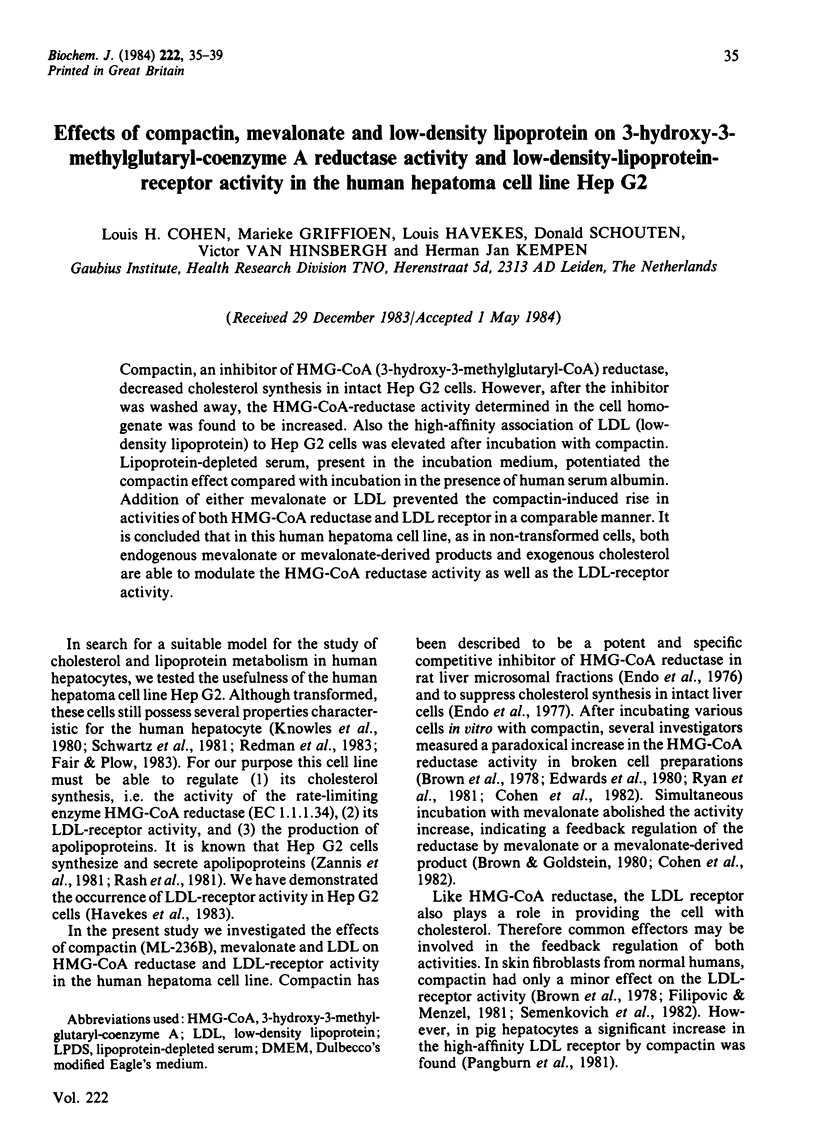
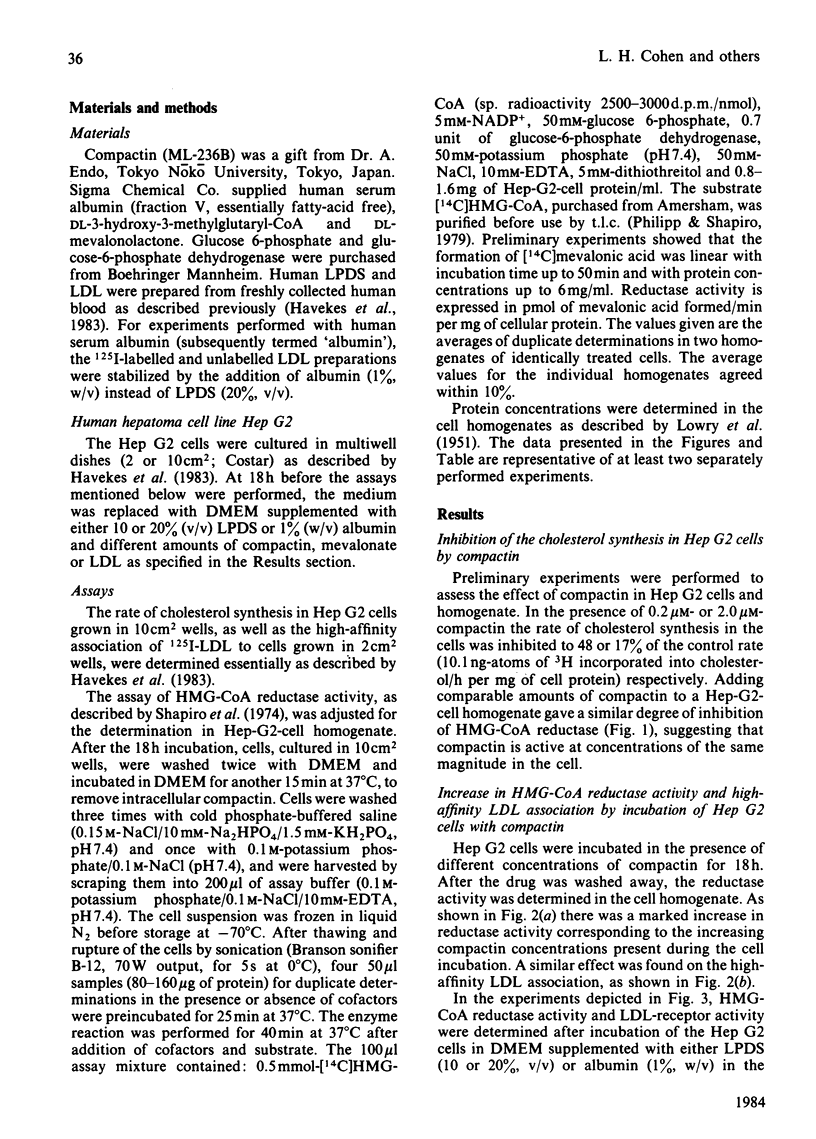
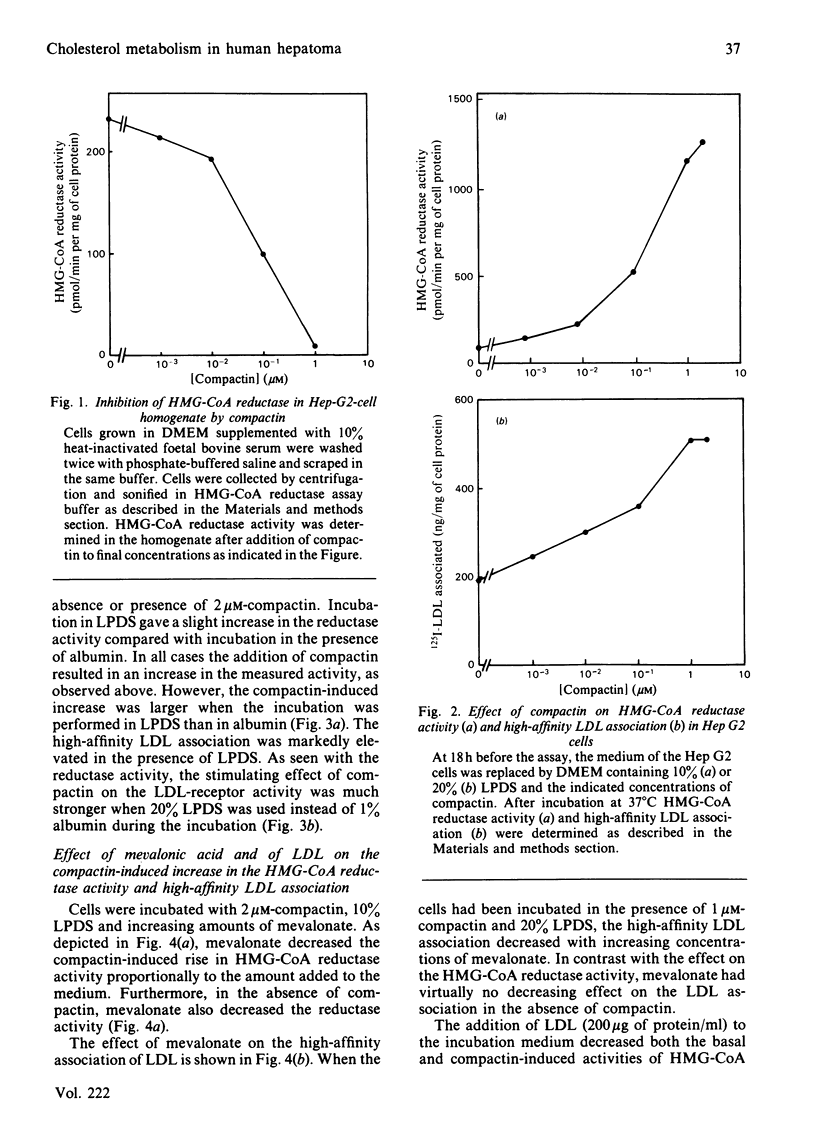
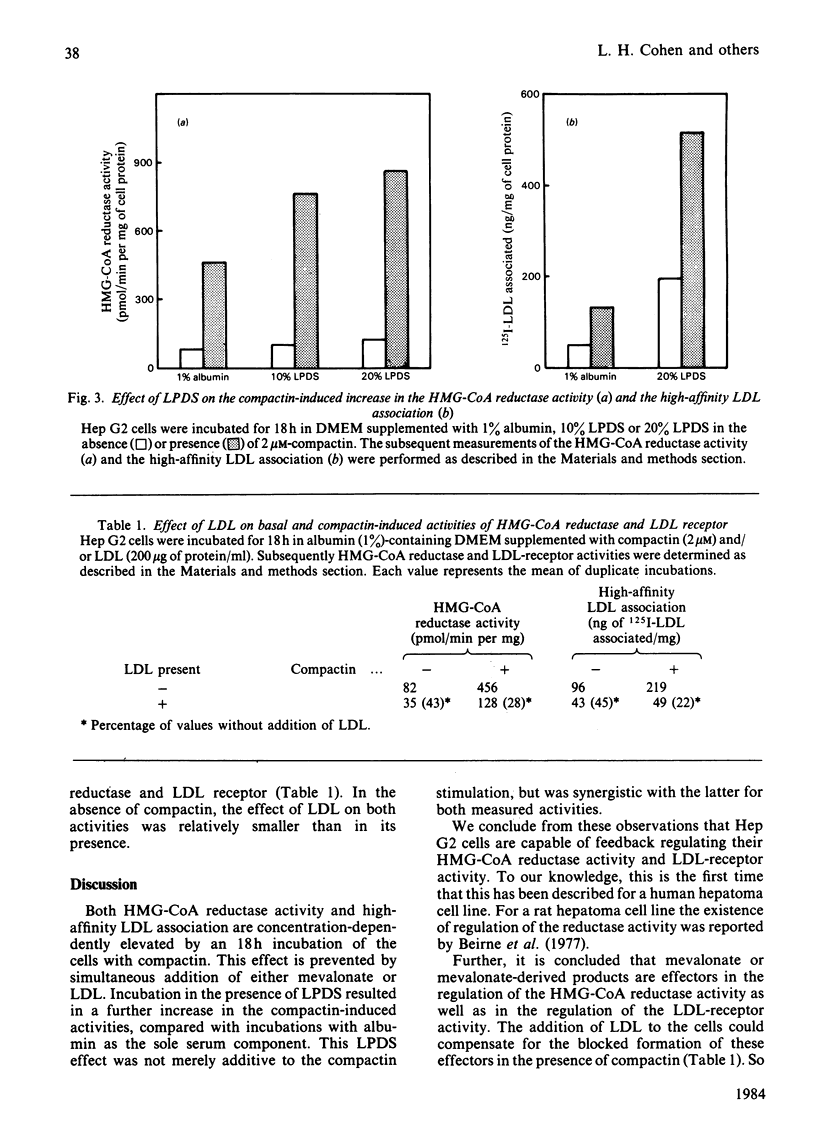
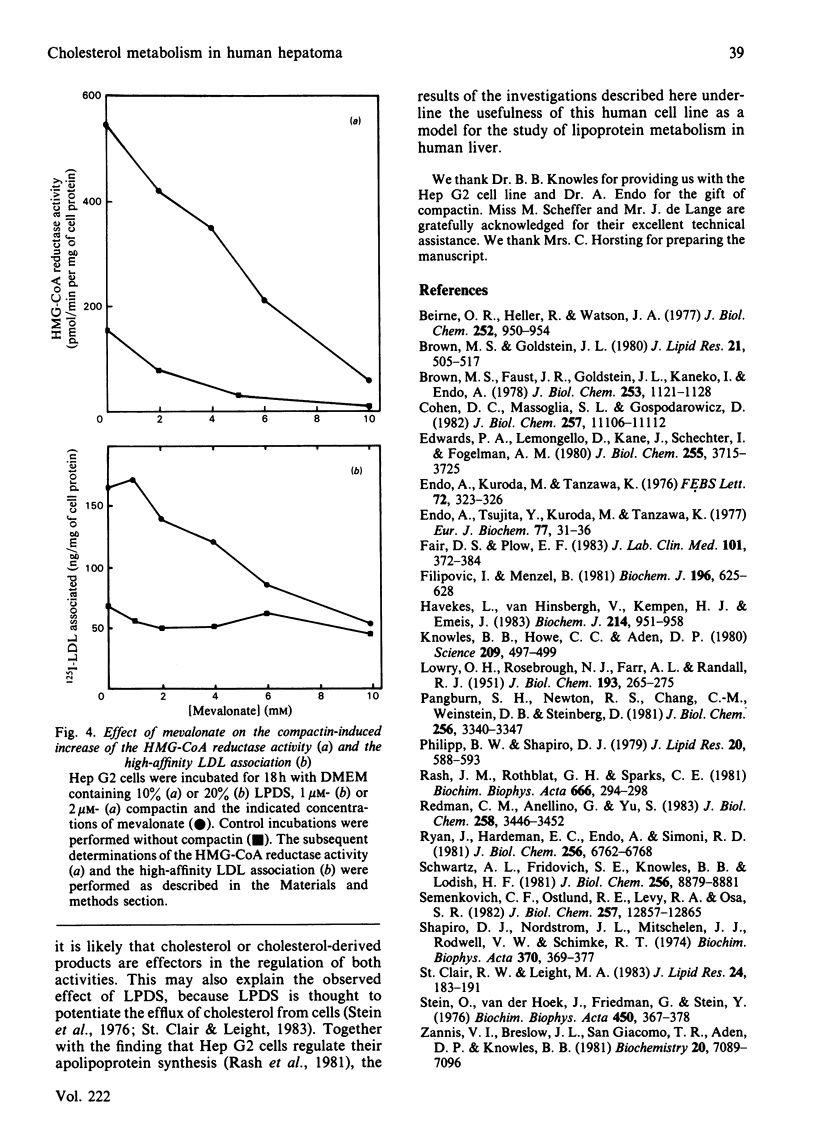
Selected References
These references are in PubMed. This may not be the complete list of references from this article.
- Beirne O. R., Heller R., Watson J. A. Regulation of 3-hydroxy-3-methylglutaryl coenzyme a reductase in minimal deviation hepatoma 7288C. Immunological measurements in hepatoma tissue culture cells. J Biol Chem. 1977 Feb 10;252(3):950–954. [PubMed] [Google Scholar]
- Brown M. S., Faust J. R., Goldstein J. L., Kaneko I., Endo A. Induction of 3-hydroxy-3-methylglutaryl coenzyme A reductase activity in human fibroblasts incubated with compactin (ML-236B), a competitive inhibitor of the reductase. J Biol Chem. 1978 Feb 25;253(4):1121–1128. [PubMed] [Google Scholar]
- Brown M. S., Goldstein J. L. Multivalent feedback regulation of HMG CoA reductase, a control mechanism coordinating isoprenoid synthesis and cell growth. J Lipid Res. 1980 Jul;21(5):505–517. [PubMed] [Google Scholar]
- Cohen D. C., Massoglia S. L., Gospodarowicz D. Feedback regulation of 3-hydroxy-3-methylglutaryl coenzyme A reductase in vascular endothelial cells. Separate sterol and non-sterol components. J Biol Chem. 1982 Sep 25;257(18):11106–11112. [PubMed] [Google Scholar]
- Edwards P. A., Lemongello D., Kane J., Shechter I., Fogelman A. M. Properties of purified rat hepatic 3-hydroxy-3-methylglutaryl coenzyme A reductase and regulation of enzyme activity. J Biol Chem. 1980 Apr 25;255(8):3715–3725. [PubMed] [Google Scholar]
- Endo A., Kuroda M., Tanzawa K. Competitive inhibition of 3-hydroxy-3-methylglutaryl coenzyme A reductase by ML-236A and ML-236B fungal metabolites, having hypocholesterolemic activity. FEBS Lett. 1976 Dec 31;72(2):323–326. doi: 10.1016/0014-5793(76)80996-9. [DOI] [PubMed] [Google Scholar]
- Endo A., Tsujita Y., Kuroda M., Tanzawa K. Inhibition of cholesterol synthesis in vitro and in vivo by ML-236A and ML-236B, competitive inhibitors of 3-hydroxy-3-methylglutaryl-coenzyme A reductase. Eur J Biochem. 1977 Jul 1;77(1):31–36. doi: 10.1111/j.1432-1033.1977.tb11637.x. [DOI] [PubMed] [Google Scholar]
- Fair D. S., Plow E. F. Synthesis and secretion of the fibrinolytic components, including alpha 2-antiplasmin, by a human hepatoma cell line. J Lab Clin Med. 1983 Mar;101(3):372–384. [PubMed] [Google Scholar]
- Filipovic I., Menzel B. Action of low-density lipoprotein and compactin, a competitive inhibitor of 3-hydroxy-3-methylglutaryl-CoA reductase, on the synthesis of dolichol-linked oligosaccharides and low-density-lipoprotein receptor in human skin fibroblasts. Biochem J. 1981 May 15;196(2):625–628. doi: 10.1042/bj1960625. [DOI] [PMC free article] [PubMed] [Google Scholar]
- Havekes L., van Hinsbergh V., Kempen H. J., Emeis J. The metabolism in vitro of human low-density lipoprotein by the human hepatoma cell line Hep G2. Biochem J. 1983 Sep 15;214(3):951–958. doi: 10.1042/bj2140951. [DOI] [PMC free article] [PubMed] [Google Scholar]
- Knowles B. B., Howe C. C., Aden D. P. Human hepatocellular carcinoma cell lines secrete the major plasma proteins and hepatitis B surface antigen. Science. 1980 Jul 25;209(4455):497–499. doi: 10.1126/science.6248960. [DOI] [PubMed] [Google Scholar]
- LOWRY O. H., ROSEBROUGH N. J., FARR A. L., RANDALL R. J. Protein measurement with the Folin phenol reagent. J Biol Chem. 1951 Nov;193(1):265–275. [PubMed] [Google Scholar]
- Pangburn S. H., Newton R. S., Chang C. M., Weinstein D. B., Steinberg D. Receptor-mediated catabolism of homologous low density lipoproteins in cultured pig hepatocytes. J Biol Chem. 1981 Apr 10;256(7):3340–3347. [PubMed] [Google Scholar]
- Philipp B. W., Shapiro D. J. Improved methods for the assay and activation of 3-hydroxy-3-methylglutaryl coenzyme A reductase. J Lipid Res. 1979 Jul;20(5):588–593. [PubMed] [Google Scholar]
- Rash J. M., Rothblat G. H., Sparks C. E. Lipoprotein apolipoprotein synthesis by human hepatoma cells in culture. Biochim Biophys Acta. 1981 Nov 23;666(2):294–298. doi: 10.1016/0005-2760(81)90120-x. [DOI] [PubMed] [Google Scholar]
- Redman C. M., Avellino G., Yu S. Secretion of proalbumin by canavanine-treated Hep-G2 cells. J Biol Chem. 1983 Mar 25;258(6):3446–3452. [PubMed] [Google Scholar]
- Ryan J., Hardeman E. C., Endo A., Simoni R. D. Isolation and characterization of cells resistant to ML236B (compactin) with increased levels of 3-hydroxy-3-methylglutaryl coenzyme A reductase. J Biol Chem. 1981 Jul 10;256(13):6762–6768. [PubMed] [Google Scholar]
- Schwartz A. L., Fridovich S. E., Knowles B. B., Lodish H. F. Characterization of the asialoglycoprotein receptor in a continuous hepatoma line. J Biol Chem. 1981 Sep 10;256(17):8878–8881. [PubMed] [Google Scholar]
- Semenkovich C. F., Ostlund R. E., Jr, Levy R. A., Osa S. R. Low density lipoprotein receptor activity in homozygous familial hypercholesterolemia fibroblasts. J Biol Chem. 1982 Nov 10;257(21):12857–12865. [PubMed] [Google Scholar]
- Shapiro D. J., Nordstrom J. L., Mitschelen J. J., Rodwell V. W., Schimke R. T. Micro assay for 3-hydroxy-3-methylglutaryl-CoA reductase in rat liver and in L-cell fibroblasts. Biochim Biophys Acta. 1974 Dec 29;370(2):369–377. doi: 10.1016/0005-2744(74)90098-9. [DOI] [PubMed] [Google Scholar]
- St Clair R. W., Leight M. A. Cholesterol efflux from cells enriched with cholesteryl esters by incubation with hypercholesterolemic monkey low density lipoprotein. J Lipid Res. 1983 Feb;24(2):183–191. [PubMed] [Google Scholar]
- Stein O., Vanderhoek J., Friedman G., Stein Y. Deposition and mobilization of cholesterol ester in cultured human skin fibroblasts. Biochim Biophys Acta. 1976 Dec 20;450(3):367–378. doi: 10.1016/0005-2760(76)90010-2. [DOI] [PubMed] [Google Scholar]
- Zannis V. I., Breslow J. L., SanGiacomo T. R., Aden D. P., Knowles B. B. Characterization of the major apolipoproteins secreted by two human hepatoma cell lines. Biochemistry. 1981 Dec 8;20(25):7089–7096. doi: 10.1021/bi00528a006. [DOI] [PubMed] [Google Scholar]


